|
November 1942 QST
 Table
of Contents Table
of Contents
Wax nostalgic about and learn from the history of early electronics. See articles
from
QST, published December 1915 - present (visit ARRL
for info). All copyrights hereby acknowledged.
|
My Uncle Brian was a radioman in the U.S.
Navy during the end of the Korean War era. A great story teller, he used to talk
about his Navy experiences and later times as a United Parcel Service (UPS)
tandem semi trailer driver
when he and others from my Buffalo side of the family would come to visit during
summers when I was a kid. He spent most of his enlistment on a gravy assignment
at the U.S. embassy in Australia, relaying messages between self-important bureaucrats
at the Pentagon and self-important bureaucrats at the U.S. embassy in the
Down Under.
His favorite saying about his time in the service was, "I joined the Navy to see
the world, and all I saw was the sea." I laugh every time I hear it. This
1942 article in QST magazine reports on the U.S. Navy's radio technician
training program. They actively encouraged radio amateurs to join.
The Navy Trains Radio Technicians
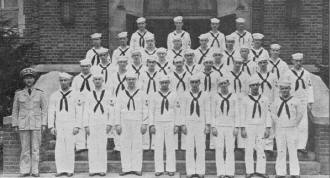
Hams in the current Navy RT class at Grove City College: First
row, I. to r.: Lt. Comdr. W. F. Grogan, US R. ex.W4QY. Commanding Officer; W3FGA.W3HYL;
W8PGM; W8TTK; W3DYM; W2LWS; W8QZO; W2NPH; W8VYM. Second row; W8SC; W3JMO.W3JWL;
W1ELR; W1EQG; W2AFM; W3JIX; W1EII; WIDZB. Third row: W200U·W3IAY; W1LTR; W80ST;
W80TO; W3GYY; W1JTG; W1NCQ. Fourth row: W3EJA; W3HHY; W8LWV; W8NNW.W8SAA; W3CTS;
W3GCI; W8KWA. Fifth row: W7HKW -ex·W2IDO; W8VZK; W3IQO. ex·AD47; W2HEO-ex.WIAZK.
Radio Hams Prepare to Learn a Fascinating New Art
This is the story of a radio technician. He's one of the lads who, sooner or
later, will be found out in the front lines - the first line, in fact, of America's
defense. On the front line of battle - and on the front line of science, too. For
his job it is to run one of the important new scienti1l'c developments that in the
end will win the war.
Not that we're going to be able to tell you just what he does, of course. That's
a deep dark secret - and we'd better all pray, fervently, that it remains so. Even
he himself doesn't know, in all probability - yet. His present job is to train himself
to the point where he will be fit to find out.
For he is a student at one of the Navy's primary EE and RM training schools.
There are seven of these schools scattered around the nation. There's one at
Grove City College in Pennsylvania and another at Utah State Agricultural College,
Logan, Utah. There are two in Texas - one at the University of Houston and another
at A&M College of Texas. Oklahoma A&M College at Stillwater has one, too,
and the Bliss Electrical School at Takoma Park, Maryland, is now devoted entirely
to this training.
Then there's the school at 190 North State Street in Chicago - except that instead
of being last on the list it should have been first, since it was the first to start
instruction and its command-ing officer, Lt. (jg) William C. Eddy, USN (Ret.), did
a great deal of the work in setting up the curriculum for the uniform course taught
at all the schools.
Which of these schools does our hero attend? Any - and all. All you have to do
is to look for a fellow with a trim white uniform, a collection of books and papers
under his arm and a look of concentrated absorption "on his face. It won't be hard
to find him, either - there are hundreds of him at each of these seven schools,
and hundreds more coming and going every thirty days or so.

Veteran or neophyte, all primary EE and RM students are taught
radio principles and practice from the ground up - and learn a lot about fundamentals
they passed up in earlier training. These photos show Grove City students in typical
lab sessions. Top - Making a study of the factors affecting the performance of a
Class. A resistance-coupled amplifier, Front, D. F. Burdett; rear, R. Spencer, ex.W2DEG.
Second from lop - Lt. Comdr. W. F. Grogan, ex.W4QY, explaining the con-struction
of one of the "bottles" from the 1-kw. ham transmitter. The 100-watt college transmitter
is visible at the right. L. to R.: R. W. Somers, RT2c, W3RRY; Lt. Comdr. W. F. Grogan;
T. S. Austin, W8RDJ, and R. J. Parker, RT2c, W8NNW. W8SAA. Second from bottom -
Obtaining data for saturation and magnetization curves of shun t and series wound
genera tors. Note the terminals and meters visible in the background; these are
on the main switchboard in the college electrical engineering laboratory. L. to
R.: W8VJV; W2LOK; unidentified; T. S. Anstin, W8RDJ, and G. M. Vrooman. Bot/om -
An experiment on tube characteristics, obtaining data for families of curves. Reading
from L. to R.: W8KWA; W8LWV; W3IQO; W3JIX; W3JMO. W3JWL, and T. S. Austin, W8RDJ,
instructor.
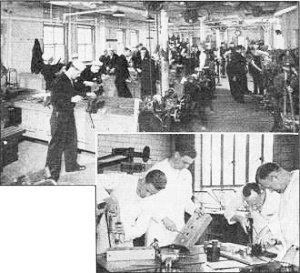
Shop work starts with bending sheet metal chassis, cutting holes,
etc., carries on through construction of 5-tube superhet. Top - Students operate
all types of machine tools in Bliss Electrical School's well-equipped machine shop.
Below -Drilling, punching and soldering chassis in Grove City's third-month radio
lab. L. to R.: W. B. Stryker; A. M. Pontus, W3FCR; F. L. Pratt, and P. H. M. Tippin.
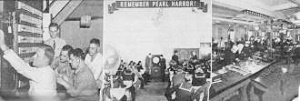
Through classroom lab and shop the Navy's radio technicians get
a thorough grounding in basic electrical principles, as well as radio, u.h.f., cathode-ray
tubes and all the rest. Left - Measuring the characteristic impedance of a telephone
line at Grove City. Front (hand on dial) W8KWA; standing, Instructor Smock, chief
operator WSAJ, owned and operated by the College; center, two Marine privates; right,
W3GCI. Center - Typical classroom scene at the 190 N. State St. school. At left
in the laboratory are Instructors William Kunz, W8SNS, and Stanley Osterlund, W9TJL,
inspecting a 20-inch Cathode-Ray Oscillograph, one of the three now in existence
in the country. At right, A. H. Brolly, ex-W6RG, chief instructor lecturing from
a drawing of a triode crystal oscillator and the E.-I. curve of a triode tube. Right
- For fifty years Bliss students learned about electricity in this testing lab,
now used exclusively in teaching Uncle Sam's sailors. Completely equipped for all
types of power and physical measurements, his work here equips the student to handle
testing and measurement problems.
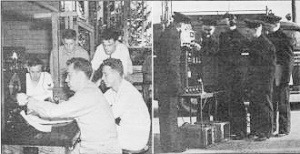
Students work in groups during lab and shop sessions. Left -
a Grove City group making measurements on an amplifier. L. to R., back row: W8LWV;
Marine Pvt. Merriam; W8RUJ, instructor. Front row: Marine Pvt. Mazzeo; W3JMO-W3JWL.
Right - Atop the Balaban & Katz building in Chicago a group of 190 N. State
St. students in-vestigate performance of equipment in frigid February weather.

No more hen-scratched circuit diagrams - the Navy wants the job
done right! Drafting class at Bliss, where students learn time-saving methods for
turning out neat, accurate mechanical drawings and schematics.
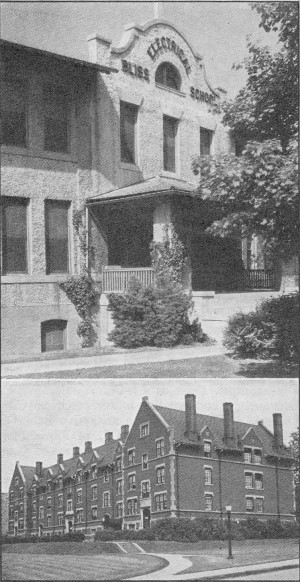
Left - Main entrance to the Administration Building at Bliss
Electrical School, near Washington, D. C. In this building are the general offices,
reference library and reading room, lecture hall, drafting and conference rooms,
machine shop and electrical testing laboratory. Below - Memorial Hall, one of the
dormitory buildings, at Grove City College. now used as barracks for the Naval and
Marine Personnel.
Let's hear from some of his buddies speaking from the campus of the Utah State
Agricultural College at Logan, Utah:
"The Battle of Logan"
"In a sparkling green valley tucked between the mountains of Northeastern Utah,
far from the whine of planes and the roar of guns, several hundred sailors and marines
are, as they call it, fighting the Battle of Logan.
"The Battle of Logan? You've never heard of it? Well, probably not. It isn't
heralded in the press or broadcast to the firesides. It is, however, far more important
than the average American will realize for some time to come.
"Who are these sailors and marines? Where are they from and what are they doing?
"Most of them held ham radio licenses or were engaged in radio repair service
in their respective home towns. Towns that ranged from the East Coast of New England
to the West Coast of California, from the plantations of Louisiana to the rolling
prairies of the Dakotas.
"Swapping white collars and work shirts for the blues of the U. S. Navy and the
forest green of the Marine Corps, these fellows are taking advantage of the chance
of a lifetime, learning more about u.h.f. than they ever would have learned elsewhere
- and with all expenses paid, plus a" salary.
"At present the Battle of Logan has its campaign of action raging at the Utah
State Agricultural College, Logan, Utah, where the men, under the command of Lt.
(jg) Carlos J. Badger, USN (Ret.), are undergoing an intensive 12-week course including
mathematics, electricity and radio. There one may hear the peculiarities of the
fundamental laws set forth by Ohm and Kirchhoff thoroughly cussed and discussed
by a dark, drawling, soft-spoken former cattleman from Louisiana and a blue-eyed
ex-highway patrolman from Iowa.
"An ex-newspaper reporter finds that learn-ing the 'five Ws' of the u.h.f. presents
several new angles. Those who are fortunate enough to be hams and are more or less
familiar with the work - well, they begrudge even taking time out to eat.
"Available to the men for their work are the well-equipped laboratories of the
College, containing more than $250,000 worth of equipment for use in radio experiments.
"During the intensive 12-week course, each man will build a u.h.f, superhet.
Another important phase of the course includes thorough drilling in the fundamentals
of a.c., d.c. and resonant circuits, motors and generators. Such a background is
necessarily required before the men are qualified for advanced training in the operation
and maintenance of the u.h.f. gear which is so vital to the Navy.
"Most of the hams attending the school are Navy men. The Navy offers men with
ham and repair work experience the opportunity to learn the secrets of u.h.f. work
which will be doubly useful to these men when: they return to civilian life. The
training alone which they are now receiving would be prohibitive in cost to them
as civilians.
"In addition to this training the Navy offers men ratings that mean the equivalent
of $200 or more per month in civilian life, All that the Navy asks in return for
this training is the willingness and cooperation of the men.
"So once again this little Mormon Valley awakens to the same fighting spirit
that was exemplified by their own pioneer ancestors, as the Battle of Logan rages
on!"
Those were the words of Marine Corps Pvt. D. E. Giersdorff and RM2c F. M. Viles.
They could as well have been speaking from the sultry plains of Texas or the
noisy bustle of Chicago's Loop or even the Nation's capital; the words might have
been different, but the thought would be the same.
For, apart from the external details of struc-tures and climate and topography,
the spirit and training at each of these schools is very much the same. And geography
doesn't seem so important in the mind of a fellow who may - and probably will -
find himself serving on the seven seas, on coral strand or frozen reef, in the air
and along the shores and on the sea.
At the Corner of State and Lake
Suppose you were talking with a student from 190. North State Street, Chicago.
"Odd sort of name for a school," you'd say. How did it get that name? Well, here's
the story.
You've probably heard of Lt. (jg) William C. Eddy, USN (Ret.). There was a Saturday
Evening Post piece about him some months ago - one of those yarns featuring extraordinary
combinations of American genius and success. Lt. Eddy is the former submarine commander
who, upon retirement from active duty, promptly began one of the most amazing inventive
careers on record. The tale of that career is far too long even to hint at here;
let it suffice to say that a couple of years ago Lt. Eddy left NBC and took a job
as televi-sion director of Balaban and Katz, operators of television station W9XBK
- which is located in the State-Lake building in downtown Chicago. That W9XBK, wholly
staffed by hams and built much like a ham rig, quickly forged into the forefront
of television research is now certainly no secret.
When the war came along B & K - as symbolized in the person of Lt. Eddy -
found there was a job to be done. The Navy needed trained men for the operation
and maintenance of its special equipment. So they turned over to the Navy a substantial
part of the space devoted to their television laboratories in the State-Lake building
at 190 North State Street - whence came the name of the school. Lt. Eddy participated
in the work of preparing the curriculum to be specified by the Bureau of Naval Personnel
for this and subsequent Radio Materiel schools. They devised a standard examination
designed to disclose the qualifications of men seeking enlistment in the new branch.
And along about the first of this year the school got going - although it wasn't
until May that the Navy made public announcement of the fact.
Now men from all over the country and from every walk of life, ranging in age
from 17 to 50, assemble daily on the top floor at 190 North State Street.
The school utilizes a wing of the television station, including three large classrooms
with the necessary secondary study halls, a reception room and the administrative
offices. Roosevelt Hall, the laboratory section, is equipped with something like
half a million dollars worth of u.h.f. transmitters, antennas, c.r. oscilloscopes,
oscillators and other special equipment. Washington Hall, with its lecture rooms,
is equipped to handle the non-technical subjects such as mathematics and radio theory.
There the V-6 reservists go for twelve weeks of intensified training. Those who
make the grade go on to receive advanced instruction.
At Grove City
The Naval Training School at Grove City College, Grove City, Pa., was the first
of its kind to be organized in the East.
Authorization for that school was given in early February, 1942, when the second
semester of the regular college course was already under way. To it as commanding
officer was assigned Lt.- ' Commander William F. Grogan, ex-W4QY, one of the original
staff at Noroton (see August QST).
In less than one month, with the unstinted aid of Dr. Weir C. Ketler, president
of the college, and Russell P. Smith, educational director, the training program
was organized and under way. It was the Noroton story over again; in that brief
time it was necessary to vacate a dormitory to provide barracks for the students,
organize an instructional staff and equip laboratories and classrooms.
On March 1st the first hundred RT2c reservists started training; by May 1st the
full complement had arrived. On this same day a Marine training detachment was authorized,
and from then on the school was jointly occupied by a mixed group of marine privates
and naval personnel.
Apart from the major business of training, each of the Navy's primary schools
has its own special attractions. Grove City is no exception. The college gymnasium
and athletic field are available to the enlisted men of the school, and various
forms of athletics - tennis, basketball, swimming, horseshoes, softball - are available
under the direction of a Chief Specialist of the Navy, Wolf Creek, which separates
the college into an upper and a lower campus, is dammed, affording an ideal skating
pond in winter,
The college is located in the pleasant community of Grove City, whose six thousand
inhabitants have warm feelings toward the uniformed men in their midst. Every Sunday
the local community swimming pool is reserved for the men of the naval school. The
local churches and homes welcome the sailors and marines. The local USO provides
varied entertainment - dances, picnics, lounges, reading rooms and many other thoughtful
aids to the maintenance of student morale in their few brief hours of relaxation.
And that's the way it is at all the schools. The circumstances may differ, but
the pattern is the same. Our information on the Texas and Oklahoma schools is not
first-hand - but we refer you to the letter from Oklahoma A&M naval station
graduate RT2c George Bird, W5HGC, on page 78 of August QST; his report of the spirit
there is sufficient evidence of the fact.
At the Nation's Capital
At venerated Bliss Electrical School over half of the initial class were hams
or former hams.
The Bliss School was established in 1893, when electricity was just coming into
widespread use and the first need arose for trained men to make installations and
supervise operation and maintenance. Its founder, Louis Denton Bliss, who began
his engineering career with the original Edison Company in the pioneer days of electric
lighting, is still its president and active head,
There, in an atmosphere hallowed in electrical annals, the students live in comfortable
dormitory bedrooms, usually two to a room, and make their daily treks over tree-shaded
walks around the oval grounds between the various buildings, the dormitories and
the dining hall:
One of the interesting features of the Bliss school is an 8-room frame house
which each year was completely wired as a practical shop project by the current
civilian class, now converted for use in special phases of the RT training.
As usual, there is a liberal sprinkling of hams on the instruction staffs of
most of these schools. For example, there is Lt.-Commander W. F. Grogan, the commanding
officer of Grove City College. As W4QY he was an active ham for many years, having
been SCM of Florida for about as many terms as there are fingers on your hand. Joining
the NCR as a ham when it was first formed in 1925, he soon moved up to command of
the Fort Myers unit. When the Noroton school was founded in the autumn of 1940 he
was ordered to join the staff there, remaining until the end of last year. On December
22, 1941, he was transferred to Philadelphia as assistant District Communications
Officer, and on Febru-ary 8th he was ordered to take command at Grove City.
As another example, take the training staff at the 190 North State Street school.
Among the instructors who are amateurs or ex-amateurs at this school are A. H. Brolly,
chief instructor, ex-W6RG; William Kunz, W8SNS; Stanley Osterlund, W9TJL William
Kusack, W9QEE; H. E. Crow, RM2c, USNR, W9FHI; E. B. Hensley, RM2c, USNR, W9HUW;
R. L. Martin, RM2c, USNR, W9CTQ; Richard Mueller, RT3c, USNR, ex-W90HZ; and Alvah
Rogers, RM2c, USNR, W90ZE.
A Look at a Radio Technician
Having seen where our radio technician lives and studies, let's look at the man
himself a little more closely. Remember, of course, that he is a composite figure
- resembling no one individual, but typical of all.
First of all, he's somewhere between 17 and 50 years of age. If he is 21 or over
he's been given a rating as Radio Technician Second or Third Class, depending on
his qualifications. He is probably - but not necessarily - a high-school graduate.
He has, however, completed at least two years of high school mathematics; the more
he knows about algebra, geometry and trigonometry, the easier the course will be
for him. His knowledge of physics will be helpful, too - and of course he has a
genuine, deep-seated interest in radio, with experience either as a ham or serviceman.
When he enlisted at his nearest navy recruiting station he was given a qualifying
examination, consisting of elementary questions on mathematics, physics, shop practice,
electricity and radio. After he passed that exam he was given the regular Naval
Reserve physical examination.
When it was all over he found himself in the Navy. His pay - which with allowances
runs as high as $130.50 per month - began the day he enlisted, and on top of that
he was supplied with uniforms, food, quarters, medical and dental care, and of course
with textbooks and training, all free of charge.
The first stage in his training began at the indoctrination station. There he
learned the rudiments of Navy life - and quickly found and almost as quickly lost
a bunch of new buddies, For in a very short while he was on his way again - this
time to the primary training school to which he was assigned.

There's more to being a Navy radio technician than just learning
radio, and the primary schools also teach Navy ideals and the Navy way of doing
things. Here a Grove City group is being instructed in the correct method of lashing
a hammock. preparatory to departure from the school. Included in the group are WSTJH.
WIDSJ. ex-W2AMM and W2NJW.
At the school he found some hundreds of other sailors or marines much like himself,
divided up first into classes and then into sections. The sections, each consisting
of some 30 or more men, are the basic instruction units. Each section has its own
instructors - usually three - and goes through the course as a unit.
He found that he was required to put in a minimum of a 70- to 8O-hour week, 7
days a week - half of the time being spent in class and shop, the remainder in supervised
study. He found that he spent 4 hours of each day in lecture and 4 hours in the
laboratory, the actual periods being two hours long minus a 10-minute rest period
at the end of each hour.
He found, too, that it was to his own advantage to attend every period in an
alert, receptive frame of mind, and to get in his outside studying faithfully, as
well. For, because of the intensive nature of the three-month course, every step
interlocks with the next and all study assignments are carefully chosen and coordinated.
And when a subject is covered it's finished - there's no backtracking.
Here is the program for a typical day:
0600 Reveille. Bunks are made and rooms cleaned by 0620.
0630 All hands assemble for 30 minutes of setting-up exercises and
drill.
0710 Breakfast.
0800 Classes and laboratory; two 2-hour periods.
1200 Lunch.
1300 Classes and laboratory; two 2-hour periods.
1700 Evening meal.
1830-2000 Athletic program and study period.
Course Stresses Math and Theory
As the training gets under way he finds that it is divided into four main headings:
D.c. theory, and mathematics, a.c. theory and radio. The first two months are devoted
to intensive math drills, physics, direct current and mechanical drawing.
And if he thinks that he already knows enough about these subjects to get by,
he is in for some stiff disillusionment. Regardless of how good his earlier training
may have been, he'll find there's plenty he didn't know. There was one graduate
electrical engineer from Ohio State we were told about who - well, there's no need
to go into details, but by the time he realized how far behind he was, it was almost
too late. Even veteran hams with years of practical and theoretical background find
they have to give the course everything they have.
Besides the study of textbooks and the art of the slide rule and drawing pen,
there's plenty of shop work, too. The text and lectures are supplemented in the
laboratories with experiments on series and parallel circuits, generator characteristics,
Wheatstone bridge measurements, vacuum tube construction and many others.
The students are given intensive courses in the fundamentals of radio construction
and operating principles. There are lessons on oscillators, detectors, amplifiers,
coupling, transmitters, antennas and all phases of radio.
Here is Lt.-Commander Grogan's description of the final month in the course as
given at Grove City:
"The course in alternating currents includes a detailed study of the principles
of a.c., various series and parallel circuits, resonance, polyphase voltages and
currents.
"The theory of the construction and operation of a.c. machinery, rectifiers and
transmission lines is taken up. A trip is taken through the local light and power
plant to study this machinery in actual operation.
"It is in this third month that the hams are in their glory. During the first
three weeks, four hours per day are devoted to radio and electrical experiments.
There are experiments dealing with resonant circuits, tube characteristics, Class
A, Band C amplifiers, frequency response of transformers and amplifiers and many
others. The well-equipped college electrical and radio laboratories are extensively
used. In the electrical laboratory there are all types of single and polyphase a.c.
and d.c. machinery, transformers and a large central switchboard.
"The radio laboratory offers many opportunities for the ham. The college owns
a 1 kilowatt ham rig (W8NXW) and a 100-watt broadcast station (WSAJ) on 1348 kc.,
also a complete Western Electric loading panel and line-test apparatus. The latter
setup allows the men to test the frequency response of from 1 to 60 miles of telephone
line. Oscilloscopes, vacuum-tube voltmeters, signal generators and beat frequency
oscillators all aid in making the experiments vivid and complete.
"The last portion of the third month is spent in receiver construction. Then
the ham's true nature comes to the front. He aids the instructors in teaching those
with little or no previous radio training; he advocates his pet type of detector
or oscillator, and bets his partner that his own set will have the greatest selectivity
and sensitivity.
"When completed, these sets are tested with the 'scope and analyzers, To more
fully explain the construction and theory, demonstrations are given on the RCA dynamic
demonstrator in conjunction with the 'scope, signal generator and audio oscillator.
"Finally, the third month ends. The hams leave with a more complete understanding
of the whys and wherefores of their work. To some come dreams of new and better
receivers and transmitters; to others the future holds the promise of a new thrill
building a rig and having many QSOs, with their new-found friends and associates."
Graduates go on to secondary schools of more immediate importance, however, is
that - if he has made the grade - the new graduate is transferred to a secondary
school for advanced training. He may, too, be advanced to a rating of Radio Technician
First Class or even Chief Radio Technician, with a base pay of $126 a month plus
substantial allowances.
His primary training alone, however, will ensure him an education equivalent
to that given by electrical engineering courses in commercial schools, plus the
special u.h.f. and cathode ray training he receives. In other words, he'll have
a good grounding for a career in commercial frequency modulation and television
as well as the more commonplace uses of radio and electricity when the war is over.
The radio world of the future is going to hear a lot from these naval radio technicians.
Some, of course, will return to their original fields when it's all over - for they
come from every niche in life. A good percentage of the students are hams and ex-hams,
of course. Many are radio servicemen, d.c. station operators, commercial announcers,
remote control men, oscilloscope experts and electrical and chemical engineers.
Others are lawyers, chiropractors, accountants; we even found an undertaker in one
of the schools (and he was near the top of his class, too!).
The ham is the nucleus, though. "We think highly of the amateurs," said Lt. Brady
F. Dayton, resident officer at the Bliss school. " Amateurs throughout have made
unusually good students," is the judgment of Lt. Eddy.
And those without amateur background quickly become inoculated with the bug -
even though they can do nothing more right now than scratch the itch. "It is interesting
to hear the remarks of those graduated, those going into a more advanced and specialized
training," Lt.-Commander Grogan commented, "They say, 'We'll be seeing you on the
air after this job is done,' or, 'I've never been an amateur or had a rig, but I'll
sure have one after the war.'''
They will - you can be sure of that. But in the meantime they have a lot to learn
and a whale of a big job to do. They'll do it, too - you can be equally sure of
that.
-C.B.D.
Posted July 10, 2023
(updated from original post
on 4/4/2011)
|

















